Playback speed:
A Dementia-Inclusive Design Process
Common Features Across Various Dementia-Inclusive Design Principles
Homely & Familiar Environment
“Home” symbolizes comfort, safety, and security for many individuals. A homely environment that is familiar to persons living with dementia can provide them with the feelings of security, comfort and warmth. A familiar environment can also help them to know where they are and find where they want to go, further promoting independence and supporting wayfinding. An environment should therefore be familiar to the person living with dementia and reflect the characteristics of a typical Singaporean home setting.
Safety
Supporting Cognitive & Functional Abilities
A well-designed supportive environment can compensate for the cognitive impairments and functional limitations that dementia causes. Some ways to support the remaining abilities of persons living with dementia include:
- Appropriate and adequate lighting help to reduce eyestrain and improve depth perception
- Strong colour contrasts between table tops and dinnerware help to improve differentiation
- Not too much patterns in walls and flooring help to prevent distraction
Appropriate
Environmental/ Sensory Stimulation
Too many stimuli in the surroundings can overstimulate persons living with dementia, leading to negative behavioural changes (e.g., confusion, disorientation, agitation, anxiety, etc.). A calm and serene environment can alleviate distress and minimize behavioural changes.
Thus, to support persons living with dementia to interact positively with their surroundings, there should be a balance in the amount of stimuli that they are exposed to. Negative stimuli should be reduced and positive stimuli should be encouraged.
Avoid exposure to:
- Loud noises and continuous sound
- Drastic swings in temperatures
- Inadequate lighting
- Bright and confusing prints
Empowerment & Autonomy
Personal Space & Privacy
Physical spaces of different functions can be created for persons living with dementia. There should be a space for them to get some privacy and enjoy quiet moments by themselves.
In centre-based services and care facilities, physical spaces for operational functions, such as delivery of goods or rubbish collection, should be designed in a manner that they do not come into the view of persons living with dementia, to reduce interference and disturbance to them.
Activity Space & Meaningful Participation
Opportunities for Social Interactions
Accessibility
Resources on Dementia-Inclusive Design Principles
Checklists and audit tools are typically included along with dementia-inclusive design guiding principles, for laypersons, caregivers, and/or care professionals to assess and identify key areas for improvement in the physical environments to better support persons living with dementia. Most of these checklists and assessment/audit tools can be self-administered.
Some of these improvements can be as small as creating signages or changing the lightings at a low cost, while others may involve larger-scale renovations which will require a higher budget. No matter what these changes are, they can have a major impact in creating dementia-inclusive environments for persons living with dementia.
In the following sections, design guiding principles developed by subject matter experts all over the world, have been consolidated and classified according to the different settings they can be applied to. Resources which contain the abovementioned checklists and assessment/audit tools will be indicated in the tables below.
Please note that the following lists of resources of design guiding principles, and checklists and assessment/audit tools are not exhaustive. Additionally, there is no one perfect checklist or assessment/audit tool, users may select one or a combination of several tools that suit their needs.
Most importantly, one should understand and be thoroughly familiar with the guiding principles to design and create a dementia-inclusive and person-centred environment, before putting them into practice.
The section below lists resources on dementia-inclusive design for:
- Physical Environments of Various Settings
- Outdoor Environments
List of Resources on Physical Environments of Various Settings
Local Resources
Dementia-Friendly Environment Design (Basic)
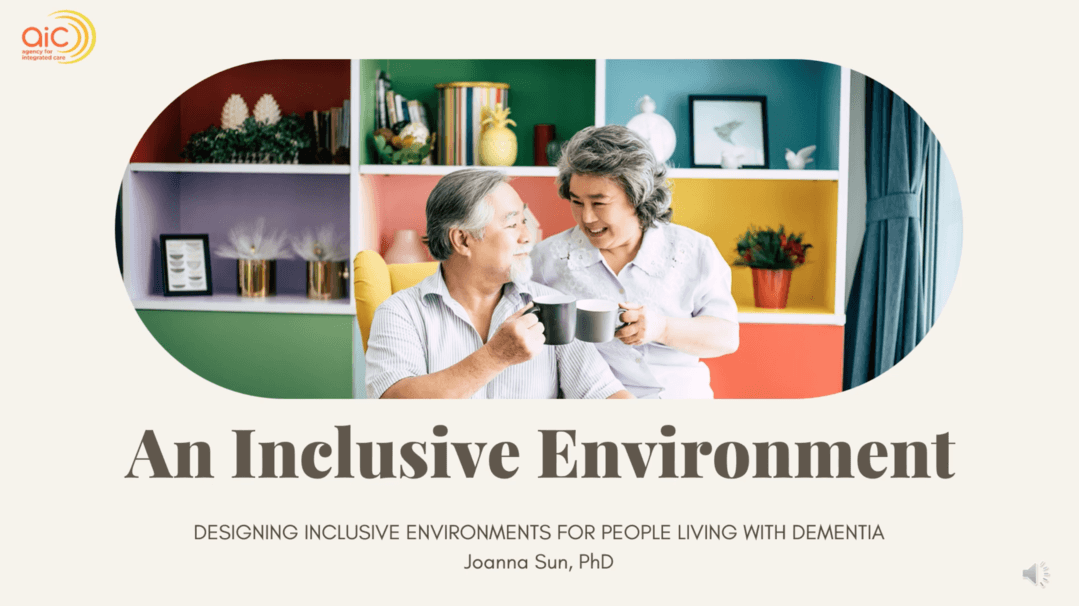
Part 1: Dementia-Friendly Environmental Design Principles
Source: Agency For Integrated Care
- Introduction to Dementia-Friendly environmental design and the role that a positive environment can have on dementia care.
- Relationship between environment and how the design principles can be applied in built environments in Singapore.
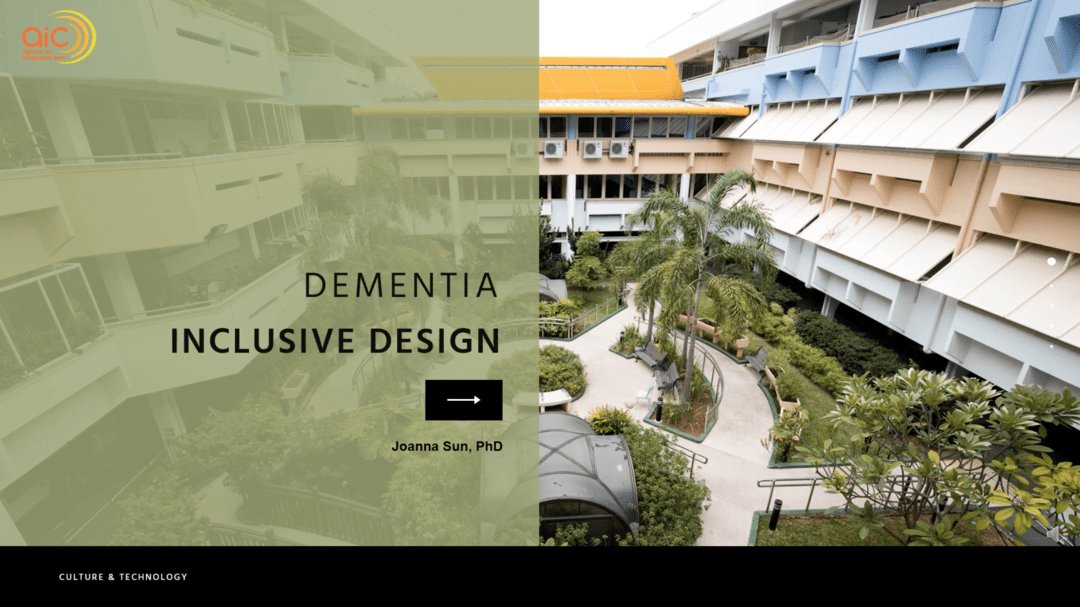
Part 2: Leveraging on Technology and Cultural Sensitivity in Dementia Care. The use of Localised Tool: Singapore Environment Assessment Tool (SEAT)
Source: Agency For Integrated Care
- Principles of Dementia-Inclusive design principles
- Understand the use of Singapore Environmental Assessment Tool (SEAT).
- The role of technology and culture in Dementia-Friendly Design.
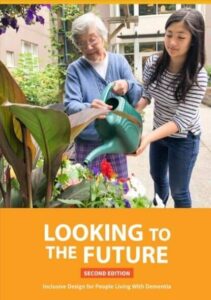
“Looking to the Future” (2nd Edition) and Singaporean Environment Assessment Tool (SEAT)
Source: Agency For Integrated Care
The second edition of “Looking to the Future” serves as a guidebook to build dementia-friendly design in community care facilities in Singapore. This booklet details the six principles in designing dementia-friendly facilities and spaces, providing recommendations and examples of how users may put these principles into practice in various physical spaces, including:
- Common Areas (lobby, lift lobbies, entrances and exits)
- Bedrooms
- Toilets and Showers
- Therapeutic Activity Spaces
- Sensory and Reminiscence Areas
- Quiet Spaces
- Dining Areas and Dry Pantries
- Therapeutic Gardens and Outdoor Spaces
The second part of the guidebook introduces the Singaporean Environment Assessment Tool (SEAT), which provides a systematic framework for reviewing environments for persons living with dementia and identifying areas for improvement. The SEAT is designed to be used by a non-design professional and can be completed by a member of staff or a person visiting the facility with minimal knowledge of dementia care.
Overseas Resources
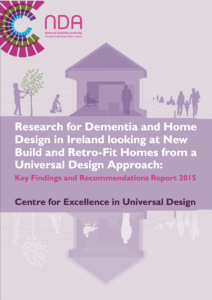
Research for “Dementia and Home Design in Ireland Looking at New Build and Retro-Fit Homes From a Universal Design Approach: Key Findings and Recommendations Report 2015
Source: National Disability Authority Ireland
The National Disability Authority in Ireland has published resources which provide useful pointers and discussion points on designing dementia-inclusive environments.
This 2015 report was written as part of a collaborative research study that was developed to underpin the development of Ireland’s national Guidelines used to inform future design of dwelling for persons living with dementia, and to retrofit existing dwellings using a Universal Design approach.
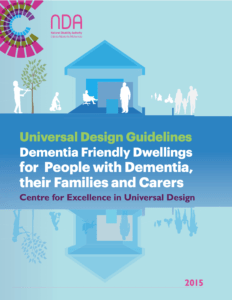
Universal Design Guidelines Dementia Friendly Dwellings for People With Dementia, Their Families and Carers Centre for Excellence in Universal Design
Source: National Disability Authority Ireland
These guidelines were developed in response to the collaborative research study detailed in the 2015 report above.
List of Resources for the Homes of Persons Living with Dementia
Local Resources
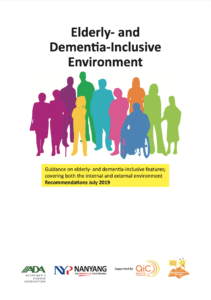
Elderly- and Dementia-Friendly Environment
Source: Nanyang Polytechnic, AIC, Dementia Singapore
This booklet by Nanyang Polytechnic, Dementia Singapore, and Agency for Integrated Care serves as a guidance and starting point for individuals who intend to build an inclusive, supportive, and sustainable environmental design in Housing and Development Board (HDB) flats/apartments where most Singaporeans reside, and in which most elderly and persons living with dementia are living with their families.
It offers recommendations on the therapeutic design of the physical environment, including both environments inside and outside (Residential Estate) of a HDB flat/ apartment.
The booklet also offers a 79-item checklist that reminds and recommends individuals the aspects to focus on when considering designing and building an elderly- and dementia-inclusive environment. This checklist focuses on the following areas:
- Spatial Environment
- Wayfinding
- Accessibility and Safety
- Lighting and Nature
- Colour Contrast
- Tranquil Environment
- Barriers or Challenges
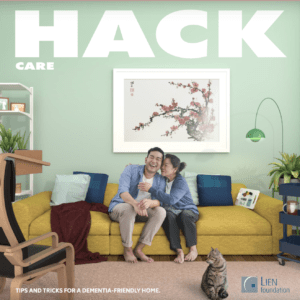
Hack Care
Source: Lien Foundation
HACK CARE by LIEN Foundation is a catalogue of more than 240 pages of ideas to make a home a friendlier environment for persons living with dementia and their families. It assembles practical hacks, surprising ideas, and simple tips and tricks to simplify a caregiver’s life as they cope with the daily challenges of caregiving, while transforming them into meaningful and enriching moments.
Overseas Resources

Making Your Home Dementia Friendly
Source: Alzheimer’s Society
The Alzheimer’s Society in the United Kingdom has developed a booklet which describes some of the ways to create a more dementia-inclusive home, to support persons living with dementia and their families.
The booklet comprises multiple sections, where each section covers a different aspect of living at home. Some of the tips offered by this booklet, may require help and support from care professionals as well. The sections include:
- Lighting
- Furniture and furnishings
- Flooring
- Eating and drinking
- Using the bathroom
- Knowing where things are
- Keeping things in order
- Keeping safe
The booklet contains a checklist that recommends some changes individuals can implement to make their homes more dementia-inclusive.
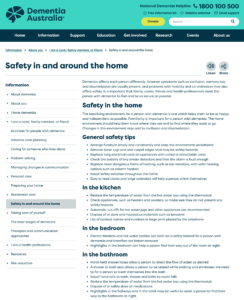
Safety in and Around the Home
Source: Dementia Australia
This resource by Dementia Australia contains tips on how friends, family, and caregivers of persons living with dementia, can improve the safety of the physical environment in and around the home.
The page comprises a simple safety checklist for individuals to assess their homes for any safety hazards.
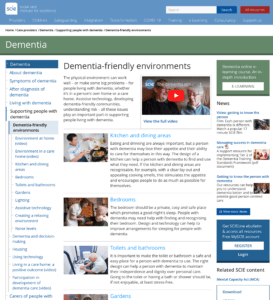
Dementia-Friendly Guidelines
Source: Social Care Institute for Excellence, UK
These resources by the Social Care Institute for Excellence (SCIE) in the United Kingdom, contain information on how the physical environments of various aspects in and around a home can be designed to be more dementia-inclusive, such as:
- Kitchen and dining areas
- Bedrooms
- Toilets and bathrooms
- Gardens
- Lighting
- Assistive technology
- Noise levels
List of Resources for Outdoor Environments Only
Local Resources
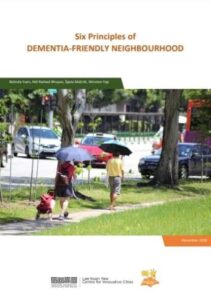
Six Principles of Dementia-Friendly Neighbourhood
Source: SUTD, AIC
The Agency for Integrated Care and Singapore University of Technology and Design have authored a document which outlines six guiding principles and features which are useful for designing dementia-friendly outdoor spaces and environments in Singapore. Good practices of dementia-friendly interventions are offered in this document for consideration as well.
Overseas Resources
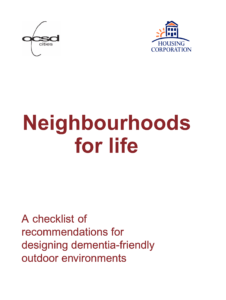
Neighbourhoods for Life
Source: Oxford Centre for Sustainable Development, UK
Mitchell, Burton & Raman (2004) have created a checklist of recommendations to help housing associations/boards improve and design dementia-friendly outdoor environments. These recommendations are supported by findings of a three-year research project.
Tell us how we can improve?
- Rapoport, A. (1990). The meaning of the built environment: A nonverbal communication approach. University of Arizona Press
- Chaudhury, H., & Cooke, H. (2014). Design matters in dementia care: The role of the physical environment in dementia care settings. In M. Downs & B. Bowers (Eds.), Excellence in dementia care: Research into practice (pp. 144-158). Open University Press.
- Agency for Integrated Care. (2021). Looking into the future (second edition): Inclusive design for people living with dementia. https://www.aic.sg/resources/Documents/Brochures/Mental%20Health/Looking%20to%20the%20Future.pdf
- Nanyang Polytechnic, & Alzheimer’s Disease Association. (2019). Elderly- and dementia-inclusive environment. https://www.aic.sg/resources/Documents/Brochures/Mental%20Health/AIC%20NYP%20Guidebook%20Eng.pdf
- Yuen, B., Bhuyan, M. R., Močnik, Š., & Yap, W. (2020). Six principles of dementia-friendly neighbourhood. https://www.aic.sg/resources/Documents/Brochures/Mental%20Health/SUTL%20Dementia%20Friendly%20Guidelines.pdf
- Chaudhury, H., Hung, L., & Badger, M. (2013). The Role of Physical Environment in Supporting Person-centered Dining in Long-Term Care. American Journal of Alzheimer’s Disease & Other Dementias, 28(5), 491–500. doi: 10.1177/1533317513488923




